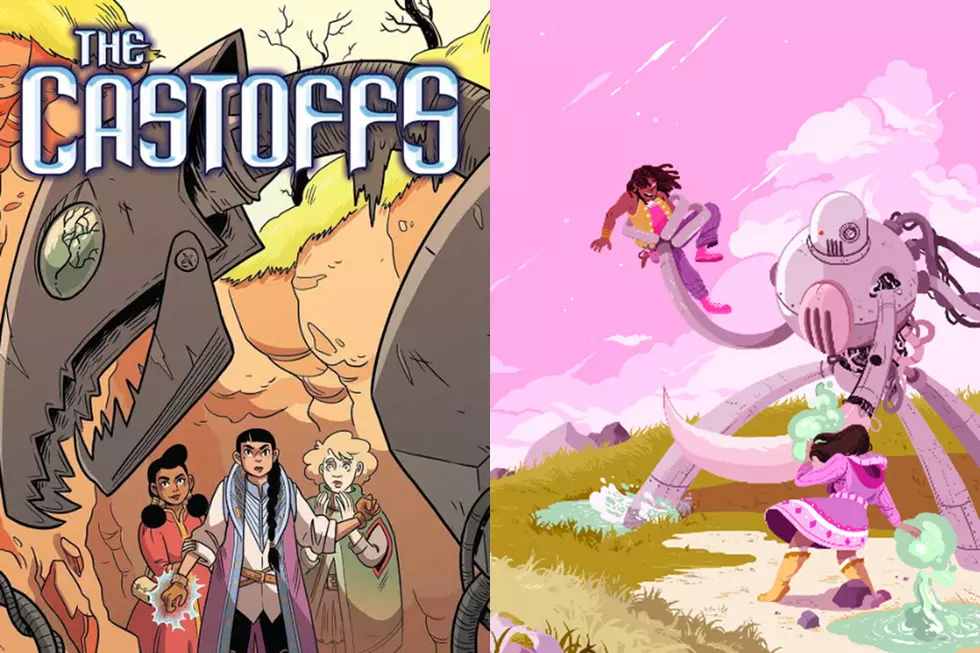![‘The Stuff of Legend’ Book Two: The Jungle [Review]](http://townsquare.media/site/622/files/2011/05/stuleg00.jpg?w=980&q=75)
‘The Stuff of Legend’ Book Two: The Jungle [Review]

No matter how old you get toys have an ability toys have to evoke powerful childhood memories of pure adoration. Of a time when a simple object like a stuffed animal or a plastic soldier could faithfully be counted on to provide so much joy. The Stuff of Legend, written by Mike Raicht and Brian Smith, illustrated by Charles Paul Wilson III, designed and colored by Jon Conkling and Michael Devito, and published by Th3rd World Studios plays with that power to weave a compelling saga of a band of loyal toys on a quest into darkness to rescue the boy they belong to.
The series second volume, The Stuff of Legend Book Two:The Jungle was released as a collection this week. It builds upon the first volume, The Stuff of Legend Book One:The Dark, giving a stronger individual identity and sense of purpose to its heroes while further building up the domain of the Boogeyman and introducing and bringing to life new adversaries and friends the toys meet along their way. It's a gorgeously illustrated and well told story with something to offer for young and old alike.

Let's get the inevitable comparisons out of the way first. When I tell you that The Stuff of Legend is about a group of toys seeking to reunite with their owner and faced with the obstacle of bitter, forgotten toys out to stop them, you're probably going to think of Toy Story, specifically Toy Story 3. It's not the fault of the creators of The Stuff of Legend that one franchise has already become so synonymous with the type of story they're telling and set the bar of quality so high.
Sure, there have been other stories to do this, like the 1986 Jim Henson movie The Christmas Toy. But if you're like me, you only remember that because watching the scenes where toys had to make sure they were never seen moving by humans or else they would instantly die forever permanently scarred you as a small child. The Stuff of Legend plays with the same themes of loyalty, jealousy, betrayal and abandonment found in Pixar's classics but in handles them in a more serious way, setting a darker tone and creating a world that taps into childhood nightmares and ensures it characters never feel completely safe. It can proudly survive the comparison to Toy Story because it's a great tale, but for all its similarities it is quite different and fully capable of standing on its own as a book worth reading.

The Jungle begins from where The Dark left off. It's 1944 and a young boy has been captured by the Boogeyman. The Boy's toys and his small dog Scout travel into the Boogeyman's realm, the Dark, to rescue him. In the Dark they're transformed into more realistic forms. For example the teddy bear Maxwell becomes a fierce grizzly bear and the Jack-in-the-Box Jester an agile warrior. Standing in their way is a vast army of toys previously abandoned by the boy, plastic knights, vikings, cowboys, soldiers and more who've supported the Boogeyman because he's powerful, he's frightening, and he's given them a purpose again.
As the story resumes in volume two the toys are fleeing the army, still unaware that one of their number, Percy the Piggy Bank, has betrayed them and is acting as a spy on the Boogeyman's behalf. On their path they encounter enormous monsters of clay, then later a collection of forgotten animals toys who've savagely rebelled against their former human masters and created a new society in the Jungle. And as the quest goes on, doubts begin to form and the toys begin to be pulled off onto separate paths. As each struggles with cowardice, love, pacifism or shame the rescue mission's chances for success are thrown into serious doubt.

As impressive as the story is, it's The Stuff of Legend's visuals that truly set it apart from anything else on comics shelves right now. Charles Paul Wilson III's illustrations create a timeless beautiful fantasy world filled with great characters. His animals like bestial and yet are able to convey a full range of human emotions. His enormous cast of human-shaped toys each communicates so much information about who they are, even if they're only in one panel.
Wilson's ability to create different visual styles for the real world and the Boogeyman's realm continues to impress, although it's on display less often in Volume Two than it was in Volume One simply because far more of the story takes place in the Boogeyman's domain. Even the book's design is striking. It's presented on a more square shaped page and with page borders given an artificial weathered appearance that makes the work feel like some beloved old children's picture book. Adding to the sense that this is some lost classic passed down through the generations.

It's worth noting that, although at times violent and scary, The Stuff of Legend could easily be as appealing a book to children as it is to adults. The characters' motivations may well create a complex and rewarding narrative, but it's their elegant simplicity on an individual level that makes the story work so well.
There's Harmony, the angel who does not wish to harm another and struggles with the necessity to take up arms to defend the boy. There's Percy, a coward who does not want to see his friends hurt but does not want to see himself hurt most of all. And there are new characters introduced here, the Knight who was once the Boy's favorite toy but was lost and now leads the Boogeyman's army. Out of fear he continues to fight his master's fight, but regrets what might have been. Or Monty, the cymbal-banging, fez-wearing monkey who was the Boy's first toy. Lost long ago, he has resigned himself to his place in the Jungle and is willing to share what he knows of the place's history.
Each helps examine the book's ideas of abandonment and loyalty from a new angle. And as the epic fight scenes and surprise revelations build to the conclusion of The Jungle, The Stuff of Legend signals that it has the potential to continue its story on an even greater scale and continue to develop its impressive cast of characters.
More From ComicsAlliance



![Lumpy Space Prince Calls Out Cooties In ‘Adventure Time With Fionna & Cake’ #2 Backup [Preview]](http://townsquare.media/site/622/files/2013/01/fionnacake02capreview-main.jpg?w=980&q=75)
![Splinter Takes Center Stage in ‘Teenage Mutant Ninja Turtles Microseries’ #5 [Preview]](http://townsquare.media/site/622/files/2012/06/tmntmicroseries5splinterpreviewmain.jpg?w=980&q=75)

![Charles Paul Wilson III Plays With The Avengers, the TMNT and More [Art]](http://townsquare.media/site/622/files/2012/02/charlespaulwilsoniiimain.jpg?w=980&q=75)
![History’s Greatest Artists Homaged in April Avengers Variants [Art]](http://townsquare.media/site/622/files/2012/01/untitled-1-1327351365.jpg?w=980&q=75)

